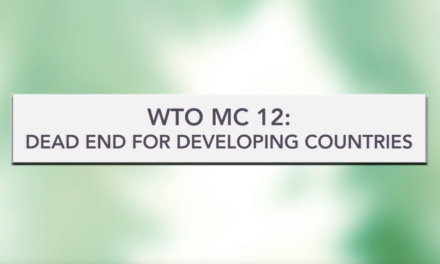by Walden Bello, The Nation Newspaper, 25 March 1997, Bangkok Thailand
Tensions and wars can have a variety of causes. External conflicts among states sometimes have their roots in the internal dynamics of societies, and strategic relationships among countries are increasingly determined by economic and ecological forces.
Destabilising expansionist nationalism has often been adopted by insecure authoritarian elites to make up for their lack of legitimacy. Gobbling up East Timor and West Papua were moves of a Javanese-based dictatorship with little legitimacy that has tried to keep a restive archipelago together by focusing energies on the expansionist programme of building a ”Greater Indonesia”.
Similarly, the resurgence of nationalism in China apparently stems from the efforts of Beijing leaders to regain some of the legitimacy that was shattered by the devastating combination of the Tienanmen Square massacre and the rise of cowboy capitalism. It must be noted, however, that the expansionist dimension of this nationalist revival has been greatly exaggerated by western propagandists.
Political participation
In an era when demands for political participation are greater than ever in Asian populations, authoritarian regimes despite their claims that their legitimacy lies in ”Asian values” are inherently unstable and their foreign policies are likely to also become more unpredictable.
Maintaining peace in the region is likely to depend more and more on the spread of democracy. For, as has often been pointed out, democracies have historically been much less prone to go to war with one another than authoritarian regimes. The reason for this empirical trend is probably that in democracies, though they may be no more than procedural democracies, there are mechanisms like checks and balances, free press, and public opinion which assure that, even if a democracy has wrongfully gone to war, its policy can be reversed.
Authoritarian regimes do not have such checks, and a fundamental change in external policy often takes place only with the overthrow of the regime.
The correlation between peace and democracy must not be inflated. After all, the most aggressive power these days is the United States a unique imperial democracy which also possesses one of the most destabilising nationalist ideologies around, with its deeply rooted sense of America being God’s own country and its volatile brew of free market messianism, missionary promotion of procedural (as opposed to substantive) democracy and deep-seated belief in Anglo-Saxon cultural superiority.
In any event, a multilateral security system is not sufficient. To achieve lasting peace, it must be accompanied by the spread and deepening of democratic processes throughout the region.
Perhaps one of the most ultimately destabilising forces from a regional security standpoint is the model of economic growth that has been adopted from Russia to Australia. Elites in practically all Asia-Pacific countries see high-speed growth as the overriding national objective, with four to five per cent growth rates considered low and the 10 to 15 per cent rates achieved by Thailand, South Korea, and China during the last decade regarded as ideal.
We can easily imagine the consequences of 16 countries all independently pursuing high-speed industrialisation in a region with a limited resource base and with resource concentrations and ecosystems that cut across national boundaries.
Oil-rich areas like the hazy maritime boundaries between China and Vietnam or the Spratlys get invested with geostrategic and geoeconomic significance.
Exploitation of river systems like the Mekong, which runs through six countries, becomes a national and regional security issue. The development plans of the countries along the river become the object of great concern. Countries lower down, like Vietnam and Cambodia, worry about the impact on water flow, biodiversity, and agriculture of China’s grandiose hydroelectric plans in the upper reaches of the Mekong. One unstated question is: What if somebody upstream seeks to use hydroelectric management as a weapon to push strategic objectives?
When several countries belong to the same sensitive ecosystem, like the Sea of Japan-East China Sea-Yellow Sea complex, the industrial plans pursued by your neighbours become your problems, since you absorb their environmental consequences. Thus Japan looks warily across the sea at the breakneck industrialisation in China, which is dependent on burning high sulfur coal. Similarly, Chinese and Koreans worry about the fallout that might also affect them should a bigger cataclysm than the recent accident at Tokaimura reprocessing plant take place in one of Japan’s 48 nuclear plants.
Multilateral environmental regimes dealing with common resources and shared environmental problems must be part of a larger multilateral peace and security system.
However, such regimes are still on the drawing board. The longer serious attention is not paid to negotiating and implementing them, the greater the danger that resource and environmental issues might be resolved through the threat of the use of arms.
Yet multilateral environmental and security systems are but one step in addressing the destabilising consequences of unsustainable high-growth policies.
More critical in bringing about greater regional security in the long run is the dethroning of the environmentally unsustainable high-growth model itself. This is, of course, an enormously difficult task for it would mean, among other things, radically reducing consumption in the advanced economies of the region.
In the newly industrialising economies of Asia, it would mean moving toward lower growth rates, effective population control, and more equitable income distribution. Income redistribution will be a big challenge, since among the key reasons Asia’s elite have opted for a high-speed growth strategy is that this leads to the creation of a larger economic pie. This allows the elite to retain unequal structures of income distribution and asset control simply by expanding the absolute volume of resources distributed to disadvantaged classes.
Trade and the military
Trade is often seen as a relationship that promotes peace. But in the current period, trade conflicts have increasingly marked the relations among nations, particularly between the United States and larger Asian economies.
Almost all of them have been shortlisted as candidates for retaliation under either Special 301 or Super 301 of the US Trade Act of 1988, which mandates the US executive to take retaliatory measures against those regarded as ”unfair traders” or ”violators” of the intellectual property rights of US firms.
Lately, the Americans have tried to convert both the newly founded World Trade Organisation (WTO) and the Asia Pacific Economic Cooperation (Apec) into blunt instruments to pry open Asian markets.
The US crusade goes beyond opening up markets and aims to transform the economic structures of Asia’s state-assisted capitalist economies along radical free market lines to create the so-called even playing field where American firms would have the competitive advantage. As US Assistant Secretary of State Joan Spero told Congress in 1995, Washington’s aim in Apec is to ”get government out of the way, opening the way for business to do business”.
And the single-minded business of both US corporations and trade officials is to reassert a US trade and investment presence in an area which promises to be the driver of the world economy in the first decades of the 21st century.
For some time a game of pretend has been going on in the region, with most governments being players.
The game has rested on the overt consensus by all parties including China that the stated US military objective of providing a defence umbrella to the region was insulated from its aggressive unilateralist trade strategy of invoking threats to employ Super 301.
This consensus contrasted with the deep fears of many that US military strategy would at some point come into synch with its trade strategy, leading to a qualitatively new level of destabilisation.
Events are showing that these fears are not groundless. In the case of China, Washington has gradually synchronised its trade strategy, military strategy and diplomacy. Unilateral threats to impose Special 301 sanctions on China have increased over the last two years, accompanied by a tough policy of preventing China’s accession to the WTO.
At the same time, the Republican-controlled Congress has passed measures though they still need to be enacted into law that can only be seen as meant to confront China, including the supersession of the US-PRC communique of 1982 restricting US arms sales to Taiwan by US Congress’ Taiwan Relations Act, with less restrictive provisions on arms transfers; a directive to the US executive to grant visas to all Taiwanese officials visiting the US ”in a private capacity”; the official recognition of Tibet as ”an occupied country” and the creation of the post of ”special envoy” to it; and the establishment of a Radio Free Asia to beam propaganda to China.
Meanwhile, the Clinton administration has announced a policy of keeping US forces in the Asia Pacific at no less than 100,000 thus revoking the reduction declared by the Bush administration and sent two aircraft carriers to the South China Sea to intimidate Beijing during the Taiwan Strait Crisis last year.
Synchronising strategies
This synchronisation of trade and military strategies evident in the case of China is likely to become the trend in US policy towards Asia in general. For Washington realises that geoeconomics and geopolitics are inextricably twined. Without a strong US economic presence in Asia, US political and military elites know that Washington will not be able to finance its strategic hegemony in the region and globally, and could end up like the Soviet Union, a superpower that collapsed owing to the lack of resources to maintain its military power.
At the same time, US elites know that without a massive military presence acting, among other things, as the ultimate threat to those who do not open up their markets to US goods and investment, the US would suffer the fate of Japan an economic power but one that is neither respected nor feted because of its lack of military clout and easily pushed around, something they see illustrated by the hostage crisis in Lima.
To the sceptical, one must point out that there is, after all, a time-honoured US naval tradition of using force or the threat of the use of force to open up East Asian markets. The American military engagement with East Asia began when Commodore Oliver Perry and his ”Black Ships” entered Tokyo bay to demand that the Shogunate open Japan up to western trade, or else. The unpleasant reality before us is that the increasing synchronisation of Washington’s trade strategy and its military strategy and movements will emerge as the greatest threat to peace in the region in our times.
Walden Bello is the co-director of Focus on the Global South, a programme of Chulalongkorn University’s Social Research Institute, and a professor of sociology and public administration at the University of the Philippines. This is the third of four articles on regional peace and security.








